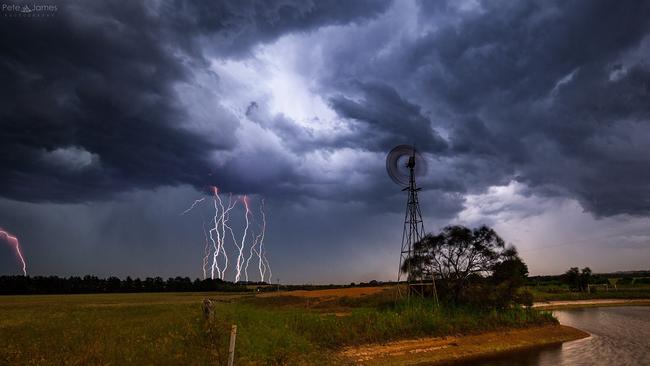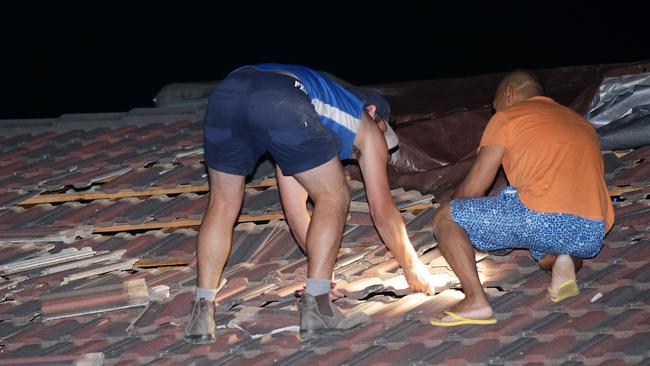‘State disaster’ as ‘rarely seen phenomenon’ thunderstorm asthma strikes in Melbourne
UPDATE: DEVASTATED friends and family are mourning law student Hope Carnevali, 20, who died after Monday night’s thunderstorm asthma disaster.
- Brights students Hope, 20, and Omar, 18, die in thunderstorm asthma
- Apollo Papadopoulos, 35, dies during thunderstorm asthma
- Thunderstorm asthma: inquiry into crisis response announced
DEVASTATED friends and family are mourning Hope Carnevali who died after Monday night’s thunderstorm asthma disaster.
Ms Carnevali, 20, died in her family’s arms in front of their Hoppers Crossing home.
It was reported she was a “lifelong asthma sufferer” and had a “severe attack” during the storm.
An ambulance did not arrive until 31 minutes later.

The law student’s uncle, John Carnevali, said Ambulance Victoria should let people know if there were going to be long delays.
“So maybe we can take them straight to hospital where it can save a life, because I’ve lost my niece, maybe for that reason,” he said in tears.
A second person is also believed to have died after a perfect storm triggered hundreds of thunderstorm asthma attacks and plunged Melbourne’s hospitals into their busiest night.
Victoria ran out of ambulances as emergency calls jumped 450 per cent, while several hospitals enacted disaster management plans.

The perfect storm of a high pollen count, northerly winds and humid conditions triggered the rare phenomenon of thunderstorm asthma from 7pm on Monday, with emergency services receiving triple 0 calls every four to five seconds and Ambulance Victoria deploying 60 extra crews.
More than 1870 calls for ambulances were made between 6pm and 11pm.
AV regional services general manager Mick Stephenson said he was aware two people had died while waiting for ambulances but it was not known if the asthma phenomenon was responsible.
Mr Carnevali described his niece as a beautiful woman who died too soon.
“She was a very kind-hearted, beautiful gorgeous little girl. She’d do anything for anyone,” he said.
“If somebody needed her, she’d be there. She was an angel. We’re going to miss her so much.”
Friends also paid tribute on social media.
Erin Carlile said: “A beautiful soul taken away too soon.”
Ashleigh Zammit wrote: “Fly high beautiful girl. Heaven has gained another angel.”
Premier’s sons suffered ‘significant asthma attacks’
Premier Daniel Andrews expressed his condolences for the families of the two people who died during the thunderstorm asthma disaster.
He promised a full investigation into what went wrong.
“Our thoughts and our prayers and our best wishes are with the families of those two Victorians who had everything in front of them, and for those families to have to deal with this tragedy is desperately sad,” Mr Andrews said.
“Our commitment to those families is we will learn from what has gone on here, we will make the necessary improvements.”
The Premier said his two sons had suffered “quite significant asthma attacks” during Monday’s storm.
Health Minister Jill Hennessy said claims that two people died while waiting for ambulances would be the subject of a full investigation.
“No doubt, there will be lessons to learn, there always are in these cases, but every part of our emergency management surge occurred correctly,” Ms Hennessy said.
Extra staff were brought into hospitals, the MFB increased its capacity to work as first responders and police conducted welfare checks, while private hospitals opened their emergency departments for public patients.
Royal Melbourne Hospital ran out of Ventolin and spacers while the Royal Children’s Hospital had almost 500 emergency presentations.
State health commander Paul Holman said this was a first in his 40 years in the job, calling it a “state disaster”.
But the man who discovered the phenomenon of thunderstorm asthma in 1992, Deakin University’s Assoc Prof Cenk Suphioglu, said it could have been predicted.
He said resources were needed to set up an alert system.


While his Deakin AIRwatch website predicted this weather combination would trigger an extreme event, Assoc Prof Suphioglu said more resources were needed to set up an alert system.
“If it is well resourced we can give alerts — how seriously they (emergency authorities) take those alerts will be up to them,” Assoc Prof Suphioglu said.
“This is a well know thing. Melbourne is dubbed as not only the allergy capital of the world, but also the thunderstorm capital of the world.”
Royal Melbourne Hospital’s director of Emergency Professor George Braitberg said they had to borrow Ventalin from neighbouring centres after seeing a day’s worth of patients in 12 hours.
“There really wasn’t any warning,” he said.
“Most people I saw weren’t asthmatics or hadn’t had it for 25 years. It was an extraordinary situation; the worse I’ve experienced in 30 years in the job.”
St Vincent’s Hospital had to enact it’s emergency management plan reserved for disasters and set up a second six-bed emergency department in its day unit when it became overwhelmed with 216 presentations — more than double what sees on a typical night.
Out of The Royal Children’s Hospital’s 500 emergency presentations — two and a half times the normal number off sick children — resulted in about 50 cases being admitted.
“Just the sheer number of patients. it is unprecedented in our history,” RCH director of general medicine Dr Tom Connell said.
“There will certainly be lessons learnt about dealing with demands, but it is hard to predict these and I think we have all coped very well by pulling together in a true team spirit.”

Harrowing hospital dash as son struggled to breath
A MUM has described the harrowing moment she was told to drive her son to the hospital while he struggled to breathe — because there weren’t enough ambulances to take him.
Stacee Krepis called 000 at 4am on November 21 after her son Nicholas, 11, had chest pains, and had struggled to breathe from about 6pm the night before.
But when the paramedic arrived to her Coburg home in a station wagon shortly after, he urged Ms Krepis she needed to take Nicholas straight to the Royal Children’s Hospital while suffering from “Thunderstorm asthma”.
“I rang the ambulance, but a paramedic came on his own, and when he saw Nicholas, he said yes, I needed to take him to the Royal Children’s straight away,” Ms Krepis said.
But after a dash to the hospital, Ms Krepis was confronted with dozens of children in the waiting room, coughing and wheezing.
“Looking at some of those kids in there, they were really struggling; it was really scary, especially seeing your child unable to breathe,” Ms Krepis said.
Ms Krepis said when she finally got to see a doctor, he told her the “line was out the door with children with similar symptoms” by midnight.

Perfect storm a rare event
“THUNDERSTORM asthma” is a rare Spring event, which occurs when a thunderstorm, sudden change in humidity, a northerly wind change and high pollen count are combined.
This perfect storm causes pollen “packages” to be blown from the north.
The humidity change bursts these capsules, which explode tiny pollens at concentrations million times higher than what is usually in the air which irritate airways.
People with mild asthma, or who have never experienced an asthma attack, are often most affected because they aren’t actively taking treatment or have management plans.
Melbourne is the “thunderstorm” capital of the world; with epidemics recorded in 1987, 1989, and November 2010.
Royal Melbourne Hospital’s head of respiratory medicine, Associate Professor Lou Irving said the event was a reminder to mild asthmatics that their condition could suddenly become severe and they needed an action plan and current medication.


